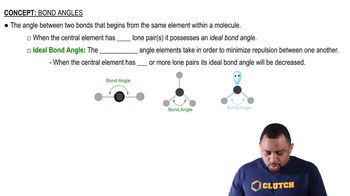Textbook Question
For each of these contour representations of molecular orbitals, identify (b) the type of MO (s or p) (iii)
 Verified step by step guidance
Verified step by step guidance



For each of these contour representations of molecular orbitals, identify (b) the type of MO (s or p) (iii)
For each of these contour representations of molecular orbitals, identify (b) the type of MO (s or p) (i)
For each of these contour representations of molecular orbitals, identify (c) whether the MO is bonding or antibonding (i)
b. The NH3 molecule is trigonal pyramidal, while BF3 is trigonal planar. Which of these molecules is flat?
Describe the bond angles to be found in each of the following molecular structures: (a) trigonal planar, (b) tetrahedral, (c) octahedral, (d) linear.
(b) An AB4 molecule has two lone pairs of electrons on the A atom (in addition to the four B atoms). What is the electron-domain geometry around the A atom?